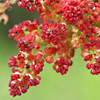Terebinth is the main contributor to the red color of the Israeli Mediterranean Maqui. The sprouting leaves and young branches are red, as is the color of the inflorescences, the fruit, and the leaves during exfoliation – all are bright and shiny red. This is a deciduous tree or shrub, dioecious, common in different regions of Israel from the north to the Judean Desert in the south, usually in single individuals. Terebinth is considered an important component of the Palestine Oak-Terebinth association, which is also named after it. In most places it grows as a shrub that reaches a height of one to two meters, but in places where it is not damaged by man and his livestock, such as near holy burial sites, it grows as a tree that can reach a height of 8-10 meters. When it is wounded, the tree secretes a resin with a characteristic scent, which is reminiscent of the scent of the mango (the mango also belongs to the Anacardiaceae family). The leaf is pinnate, its leaflets are sessile, limp, glabrous, and end in a long point. Each leaf has 4-6 pairs of leaflets, and usually another non-paired smaller leaflet at the tip of the leaf. The upper side of the leaflet is not shiny, the margin of the leaflets is entire. The axis of the leaf is cylindrical, without a margin. The leaves are alternate. In the winter the tree can be recognized by its large and pilose buds.
Pistacia palaestina blooms in the months of March-April. The inflorescence is a panicle with dense racemes of tiny flowers. The female flowers have 2-5 sepals and no corolla. The pistil is short and cleft at its stigma. The ovary is superior. The male flowers have a sepal with 3-5 lobes, and they too do not have a corolla. They have 3-7 stamens with short filaments. The stamens and the stigmas are red, and give the inflorescence its red color. The fruit is a single-seed spherical drupe with a diameter of 5 mm and a green pulp. Upon ripening it turns red to purple-blue. The red fruits are sterile. The fruits are edible. Their seeds are dispersed by birds.
Attempts to graft Pistacia vera (pistachio) on Pistacia palaestina have been successful. Elongated banana-shaped pod-like structures can be seen hanging from many Pistacia trees. These are galls caused by the aphid Baizongia pistachiae. These aphids affect the growing tips of the branches, leading to the growth of galls instead of leaves. When opening such a gall, numerous aphids can be seen, as well as their excretions. After opening of the gall and release of the aphids at the end of the season, the wall of the gall dries, but does not fall. Rather, it remains hanging on the end of the branch like a dried banana peel. Galls caused by Forda formicaria and other species of aphids from this genus are also found on leaflets of Pistacia palaestina.
Pistacia palaestina grows in the mountain regions. The common arborous plant association that is common in the Mediterranean mountain ranges of Israel is Quercus calliprinos and Pistacia palaestina. Its distribution is Mediterranean. Pistacia is mentioned in the Bible as a place of worship, and identification of this genus with the Pistacia that is mentioned in the Bible is positive. Parts of these trees that were found in ancient houses comprise almost half of the trees that were found and classified in archeological excavations in the north and center of Israel.
In folk medicine the chewed fruits are used as medicine for heartburn, peptic ulcer, toothache, stomachache, etc. The bark of the tree, after being boiled in water, is used for treatment of eczema and hemorrhage. Turpentine is extracted from the trunk after scarifying its bark. Curing materials are prepared from its galls. Its wood is carved, among others for making decorated mortars for crushing coffee beans.
Written by Erga Aloni and Mike Livne





